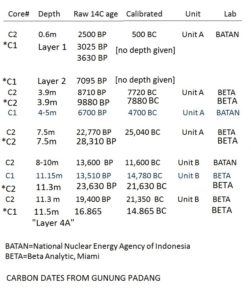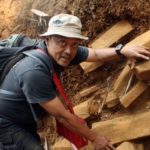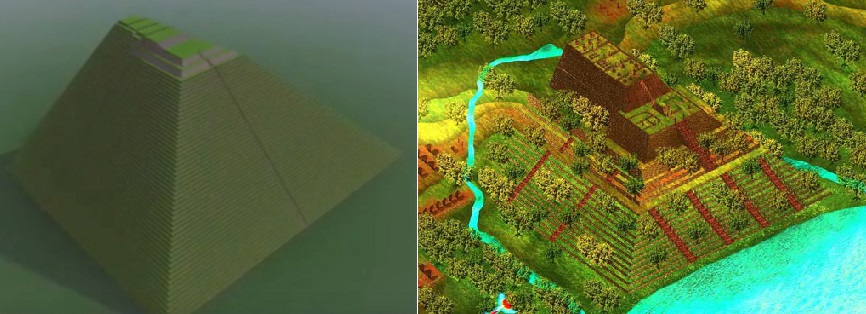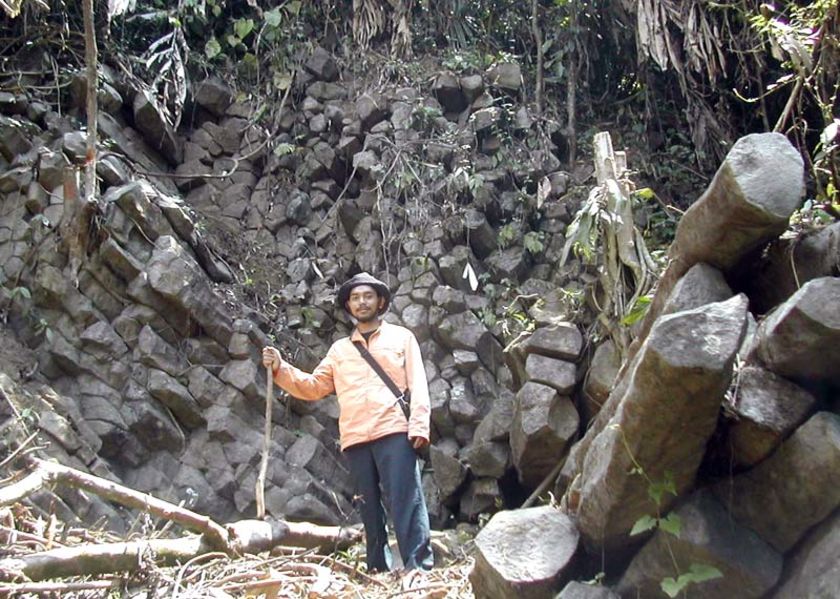GUNUNG PADANG :OPEN LETTER TO DR. DANNY HILMAN NAWATIDJAJA
I appreciate you taking the time to respond to my comments on Gunung Padang (here and here). Naturally, your comments have raised a number of further questions on my part. I’ll be addressing the points you brought forward, and quoting in part from your comments; if you feel at any time that I am cherry-picking or unfairly taking your words out of context, please let me know.
A clarifying note: I am not disputing that the surface structures on the terraces constitute an archaeological site, including much of what is inside the fence. At issue are your dating of those remains, your claims of multiple megalithic building levels going back twenty thousand years or more, and a “stepped pyramid” structure composed of terraces of horizontally laid andesite columns.
And now, to your comments.
I am a bit upset to see my data has been going out wildly in the internet without proper descriptions and explanations and of course without my consent since we have not been published them yet (in scientific journal), so it is supposed to still be considered confidential. But it is inevitable in this case, and on the other hand, I should be grateful also to see many people around the world got interested regardless of negative or positive comments. Of course, anybody would easily miss the real picture if only based their analysis on unauthorized pieces of information on the internet.
I tried to be pretty thorough before writing my critique of your work at Gunung Padang. I sought out every morsel of information I could find that you had released on the net. I watched a number of videos where you were interviewed, or where you toured the site with visiting alternative scholars, like Andrew Collins, Robert Schoch, and Semir Osmanagic of Bosnian “Pyramid” fame. I surveyed a wide sample of media reports and articles about your findings, both credulous and skeptical. Now, you say we should not make judgments or criticisms until your findings have been formally published—but your reservations do not seem to apply to the Atlantis True Believers who have been merrily building great towers of speculation on exactly the same data as I had access to. In effect, you have handed control of the Gunung Padang narrative over to the lunatic fringe, while telling those of us with any professional expertise to shut up and wait for the data. There’s something wrong with that picture.
Why you are putting yourself as a geologist who really knows about the nature of columnar joints and the columnar joints in Gunung Padang? You are misunderstood that columnar joints always vertical in nature; in fact, they could be oriented in any direction but they will always perpendicular to the cooling surface (which is about similar to the rock layer/bed).
Well, it’s true I’m not a geologist, any more than you’re an archaeologist. But that is, in fact, exactly what I said. Instead of ‘splaining it to me, you could perhaps point it out to Graham Hancock—who, as I previously quoted, believes that “…columnar basalt in its natural state is found only in the vertical formations.” Or you could even explain it to geologist Robert Schoch, who has this to say: “A key point is that these natural columns form vertically, and that is how they remain if not rearranged by humans or tilted en masse by geological processes.” And yet you later say in your comments:
Many geologists who came to the site including Robert Schoch have similar thought with me.
Okay. Who? Which geologists? I’m not terrifically impressed at Dr. Schoch being trotted out as an authority. On the one hand, a junior-college-level science instructor who is also a True Believer in some boringly fringe stuff, and apparently knows less than even I do about columnar jointing; and on the other hand—hey, not a vulcanologist, either. Which brings me to my next reason to continue being skeptical.
You are a seismologist, and (I understand) a good one. But why is it that your vulcanologist colleagues, whose major expertise lies in interpreting volcanic deposits, are (a) unimpressed by your stratigraphic reconstruction, and (b) see nothing particularly unusual about the horizontal jointing at Gunung Padang? You have claimed they did not bother to examine your remote sensing results, but I do not find that credible. I do not want to argue from authority, but that is a major red flag for me.
Which brings me to a question. I am both unclear and dubious about the surface distribution of the horizontally jointed andesite, which you interpret as the artificial “skin” of a step pyramid. How fully have you mapped it? You uncovered an area on the eastern side of the hill, but I could see no mention that you had found traces of your artificial “skin ” on the north or west faces. And I know you didn’t find it on the south, because that’s where you posit an artificial embankment of earth and river cobbles. The artists’ bold reconstructions of your Atlantean step pyramid are assuming too much, I think.
In this connection, I would be interested in your comments on the “other” Gunung Padang, the one in Cilacap. The outcrops look strikingly similar, and I see your colleague Ali Akbar has already declared this to be an ancient megalithic site similar to Gunung Padang Ciajur, only with more advanced stoneworking techniques (i.e., the so-called “locking joint.”) But can you really look at the outcrop below and deny that it is a natural formation?
Next, we’ll move on to the carbon dates. Here is what you said:
Now about the carbon dates. We have sampled and dated more than you have pointed out in your article. Most of samples were sent to BETA Analytic for the analysis.
You have radiocarbon dates that have not been published—fine, I look forward to seeing them in your formal publication, as I already said in my previous article. But I actually did, with much effort, manage to find six more dates—in screen caps taken from a slide show presented by Graham Hancock. I’d quite like to know where he got them…anyway, they’ve been added to the table, with asterisks.
publication, as I already said in my previous article. But I actually did, with much effort, manage to find six more dates—in screen caps taken from a slide show presented by Graham Hancock. I’d quite like to know where he got them…anyway, they’ve been added to the table, with asterisks.
However, they do little if anything to help your case; they are still wildly scattered, inconsistent, too few for reliability, and fatally flawed in a way I shall discuss below. I am also wondering about the three “new” dates that form pairs with dates I had already seen, the samples at 3.9m, 7.5m, and 11.3m: are these replicate measurements of the same samples?
We have four carbon dates associated with Layer 2 that suggest an age of about 7 ka consistently, though we still don’t know exactly the nature of the organic remains but I think it is fair enough to assume that the organic carbons that we dated comes from bio-organisms activity that occurred during the constructions or after, and we have sampled them carefully not to be contaminated by recent bio-organic activities. The carbon dates of Layer 3 (older) varies from, 13 ka to 25 ka, so we don’t know the more precise date but it seems to be Pre-Holocene (it means at the time before civilization that we knows of).
Are those the four dates shown on my revised table? If so, they do not look impressively consistent to me, especially if two of them are replicate measurements. But it is the second part of your comment that blows away your whole house of cards. No, you cannot reasonably make that assumption. I said this previously, and I will say it again: if you do not know what you are sampling—if you do not know the cultural relevance of what you are sampling—then it does not matter how carefully you collect your samples, and it does not matter how professional the lab is: your samples will be worthless. Your dates will be meaningless.
Now let’s take a quick look at how these dates have been presented by the Atlantis crowd, without drawing any objection or clarification from you. I quoted Graham Hancock in a previous post:
Hancock: First the drill cores contained evidence – fragments of columnar basalt – that man-made megalithic structures lay far beneath the surface. Secondly the organic materials brought up in the drill cores began to yield older and older dates – 3,000 BC to 5,000 BC, then 9,600 BC as the drills bit deeper, then around 11,000 BC, then, 15,000 BC and finally at depths of 90 feet and more an astonishing sequence of dates of 20,000 BC to 22,000 BC and earlier. (Magicians of the Gods, 2015: 36)
Now, you know this is nonsense—you know this is a gross misrepresentation of the C14 dates. Your very own data indicate you ran into the top of the natural andesite body at 15m depth; and yet Hancock implies you were taking culturally relevant C14 samples at nearly twice that depth. It is this kind of misrepresentation that you have allowed to go unchallenged, to the point where blatant and baseless nonsense has become the default narrative about Gunung Padang.
I’ll be addressing more of your comments in the next part of this letter. Just a personal note to end this part: Danny, you really disappointed me. When I first heard the rumours about Gunung Padang, I was excited and intrigued; I hoped it would be another fabulous groundbreaker, like Gobeckli Tepe. Instead, as I looked at what evidence was available, it began to look more and more like another “Bosnian pyramid”—that is to say, it began to look more and more like a hill.




